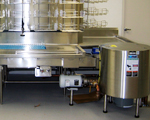Industrial plants are most often loud and dynamic work environments. Noise fields are complex with varying levels of noise produced by many different pieces of equipment, and employees spend varying amounts of time near the different noise sources. Sound levels are even impacted by the building, with taller spaces generally quieter than single story spaces, sound absorbing room finishes sucking up some of the noise, and partitions blocking sound. Measuring worker noise exposure is simple.
Place noise dosimeters on the employees, and let them do their work. However, in this complex sound field, reducing employee noise exposure can be challenging. The relative contribution of direct and reverberant sound fields must be determined. The sound level emitted by each piece of equipment must be measured, and the equipment’s contribution to the noise field at each worker position must be assessed. The amounts of time employees spend at each position or performing each task must be logged. All of this information must be analyzed so that it is possible to calculate the reduction in employee noise exposure that will result from mitigating the noise produced by individual pieces of equipment, decreasing the contribution of the reverberant or direct sound fields, or altering the amount of time that employees spend near each piece of equipment.
Factory wide noise reduction, however, can be an expensive undertaking. It is sometimes more practical for industrial facilities to take a gradual approach. First, determine if significant employee noise exposure reductions can be achieved by increasing the area of sound absorbing surfaces in the space. Occasionally, significant noise exposure reductions can be achieved by treating the ceiling or walls with inexpensive sound absorbing materials. Second, the company can write sound level limitations into specifications when procuring new equipment for the facility. Preferably, specifications should require that the equipment noise levels be measured and certified prior to installation in the plant. Over time, this approach will gradually decrease employee noise exposure.
At Acoustics By Design, we are experts at performing these assessments and in developing noise control solutions that reduce employee noise exposure. We can help by accurately measuring the noise levels and designing a comprehensive, workable solution.
